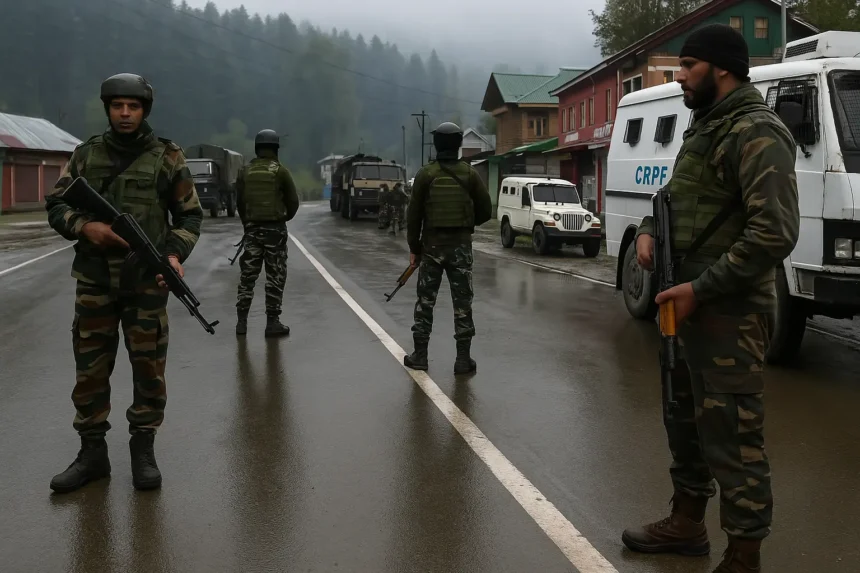Top Government Moves to Fix Pahalgam Security After Shocking Attack
In the wake of the recent terror attack in Pahalgam, a place known for its stunning natural beauty and spiritual significance, the Indian government is making swift and powerful decisions. The focus is clear: plug all security gaps before the highly anticipated Amarnath Yatra, which begins on July 3, 2025.
Why Pahalgam’s Security Now Demands Urgent Attention
Pahalgam, a serene valley in South Kashmir, turned into a hotspot of concern after the attack. The incident raised alarm bells, especially since the route to the sacred Amarnath Shrine passes directly through this region.
With lakhs of pilgrims expected to take part in the Yatra, the safety of civilians, tourists, and locals is a top priority. The government’s response? A major realignment of security forces with permanent deployment plans in motion.
1. Comprehensive Security Review Ordered
Officials have confirmed that a detailed security audit will be conducted within a day or two. This review will take into account current vulnerabilities, terrain challenges, and the increased risk due to dense forest cover around areas like Bisaran Valley.
This audit will lay the groundwork for redrawing deployment strategies across sensitive zones.
2. Permanent Army & Paramilitary Presence on the Cards
One of the biggest takeaways from early reviews is the lack of a consistent security presence in and around the Bisaran Valley—a heavily forested zone near Pahalgam.
Currently, the closest forces are:
- 3rd Battalion of the Rashtriya Rifles (Army)
- 116th Battalion of the CRPF
These units are stationed over 10-11 km away, with the route accessible only by foot or horseback.
This delay in response time is what the government aims to fix by deploying forces closer to high-risk areas.
3. Bisaran Valley to Get Immediate Security Focus
Security forces have now been tasked with setting up closer and more responsive outposts around Bisaran Valley. The plan includes:
- Covering rear forest approaches to prevent infiltration
- Ensuring 360-degree security coverage
- Using terrain-based deployment strategy for faster access
This move is seen as vital to cut down response times and eliminate blind spots.
4. Reinforced Rear Security Along the Yatra Route
Since the Amarnath Yatra attracts huge footfall through forested and mountainous paths, rear-end security is just as important as front-facing checkpoints.
Officials are actively mapping out new routes for troop mobility, helicopter reconnaissance, and communication upgrades in remote sectors to ensure full-spectrum surveillance.
5. Technology to Boost Terrain Surveillance
Expect a rise in tech-backed surveillance like:
- Drones and UAVs for overhead patrols
- Thermal imaging systems for night watch
- Satellite-assisted mapping to detect unusual movement
This digital integration will help provide real-time situational awareness for troops on the ground.
6. A New Security Grid in the Making
A complete realignment of the existing security setup is being finalized. The new grid will:
- Prioritize rapid response
- Establish static and mobile checkpoints
- Involve inter-agency coordination between Army, CRPF, J&K Police, and intelligence services
The upcoming days will see this grid deployed with full readiness before the Yatra commences.
7. Focus on Civilian & Pilgrim Safety
The Centre is deeply aware that the Amarnath Yatra is not just a religious journey, but also a symbol of India’s cultural and spiritual resilience.
Hence, extra protection measures for pilgrims are being considered:
- Bulletproof buses and convoy movement
- Escort vehicles for larger groups
- Emergency medical units with trained security personnel
This year’s Yatra will reflect a “zero-compromise” security stance from the administration.
The Road Ahead: From Reactive to Proactive Security
The shocking Pahalgam incident has reminded the country that complacency is not an option. With the clock ticking toward the start of the Amarnath Yatra, the Centre’s strong push for permanent deployment of Army and Paramilitary is a clear signal of change.
This isn’t just about securing a route—it’s about restoring confidence in the hearts of pilgrims, citizens, and the nation.
Modi’s Bold Strategy to Tackle Terrorism and Strengthen Valley Security
In response to repeated threats in Jammu & Kashmir, Prime Minister Narendra Modi’s government has adopted a proactive and uncompromising stance against terrorism, especially in sensitive zones like Pahalgam. The current move to permanently station Army and paramilitary units isn’t just reactive—it’s part of a broader long-term national security doctrine aimed at ensuring stability in the region.
Over the years, Modi’s administration has emphasized a “zero-tolerance policy” on terrorism, combining ground-level military readiness with high-level diplomatic pressure. This includes enhanced coordination between central agencies, advanced surveillance tech integration, and aggressive border monitoring to curb infiltration.
PM Modi has also consistently highlighted the importance of development-led stability—investing in infrastructure, tourism, and jobs for the local youth, thereby reducing the influence of radical networks. The Centre’s recent decisions post-Pahalgam reflect this dual-track approach: security tightening plus civilian outreach.
With Amarnath Yatra drawing near, Modi’s leadership has become even more visible, directing top-level reviews, and ensuring swift deployment realignments. It’s a signal that India won’t bow to fear—pilgrims and peace will be protected at all costs.
Final Word: Will the Yatra 2025 Be the Safest Yet?
With boots on the ground, eyes in the sky, and leadership driving the mission forward, the Amarnath Yatra this year could set a new benchmark for pilgrimage safety in India.
Stay tuned for updates on security measures, pilgrim guides, and how you can participate safely in Amarnath Yatra 2025.
Don’t miss our exclusive insights on Himalayan travel, spiritual tourism, and national security trends. Bookmark us now!
Most read: https://tnheadlines24.com/pahalgam-terror-attack/
Disclaimer: TN HEADLINES24 is not responsible for the accuracy, completeness, or reliability of the information contained in this article. The views and details presented are based on publicly available sources and official statements at the time of writing. Readers are advised to verify independently and exercise discretion before making any conclusions.

